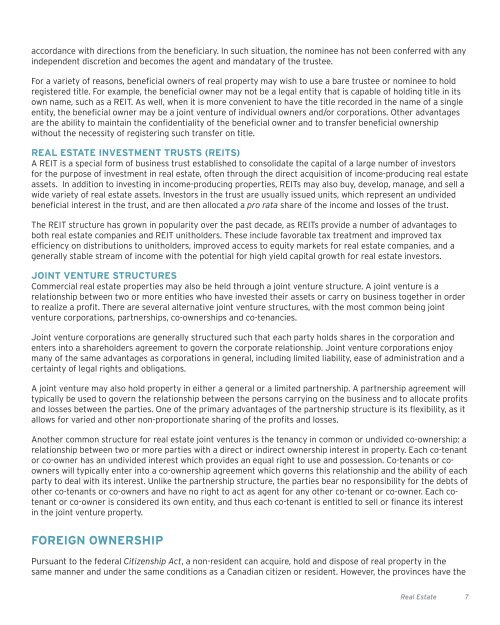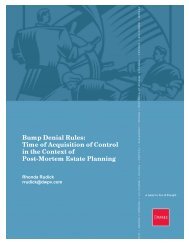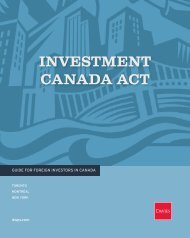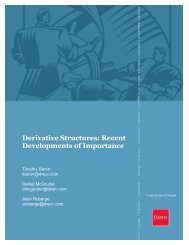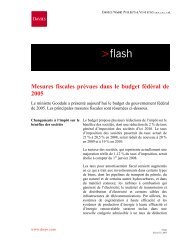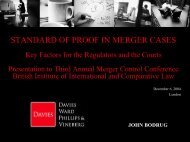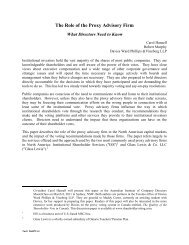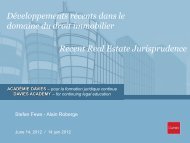REAL ESTATECanada occupies an immense geographical area totall<strong>in</strong>g 9,976,000 square kilometres, or 3,851,000 squaremiles. With a grow<strong>in</strong>g population and extensive land available for commercial, <strong>in</strong>dustrial, residential andrecreational development, Canada attracts substantial foreign <strong>in</strong>vestment <strong>in</strong> property.Based on the division of powers set out <strong>in</strong> the Constitution Act, 1867, the federal government has jurisdictionover matters of national importance, while the prov<strong>in</strong>ces have jurisdiction over matters of local importance. Withcerta<strong>in</strong> exceptions, real property is considered a matter of prov<strong>in</strong>cial jurisdiction, and each prov<strong>in</strong>ce governs theacquisition, ownership, use and development of real property with<strong>in</strong> its boundaries. Such exceptions <strong>in</strong>cludelands reserved for Canada's aborig<strong>in</strong>al people and federal ports and harbours which fall with<strong>in</strong> federalgovernment jurisdiction. Other than Québec, which is governed by the Civil Code of Québec, real property law <strong>in</strong>all other prov<strong>in</strong>ces has evolved from English common law pr<strong>in</strong>ciples.LAND TITLES SYSTEMMost prov<strong>in</strong>ces <strong>in</strong> Canada are operat<strong>in</strong>g under a computerized land titles system (under which title to realproperty is certified by the land registrar) or are convert<strong>in</strong>g from a registry system (under which title is notcertified) to the land titles system. Newfoundland and Pr<strong>in</strong>ce Edward Island are still under the registry system;the title system <strong>in</strong> Québec is governed by the Civil Code of Québec. The Québec system allows both paper andelectronic registration, but does not provide for certification of title by the land registrar.Ontario has 54 land registry offices, which register, store and manage documents such as transfers, charges andplans of survey. It is the first jurisdiction <strong>in</strong> the world to provide electronic registration of land-relateddocuments, with electronic registration be<strong>in</strong>g mandatory <strong>in</strong> some, but not all regions <strong>in</strong> Ontario.Electronic land registration replaces the need to register paper documents at a land registry office. Us<strong>in</strong>gspecialized software called Teraview, documents are registered electronically and signatures are affixedelectronically by the parties' representatives. Representatives are authorized to electronically sign, completeand register the documents. Documents prepared and submitted by authorized users of the Teraview system onbehalf of other parties are deemed to be documents of those other parties.LAND OWNERSHIP STRUCTURESMost land <strong>in</strong> Canada is held <strong>in</strong> fee simple or its equivalent <strong>in</strong> Québec (absolute ownership for an <strong>in</strong>def<strong>in</strong>iteduration) rather than on a leasehold basis (tenure where one party has the right to occupy a property for a fixedduration).USE OF NOMINEESCorporations, limited partnerships, real estate <strong>in</strong>vestment trusts (discussed <strong>in</strong> more detail below), and <strong>in</strong>dividualreal property owners often structure their <strong>bus<strong>in</strong>ess</strong> affairs so that a separate entity - usually a s<strong>in</strong>gle purposecorporation - holds registered title to real property as bare trustee or nom<strong>in</strong>ee and mandatary for the beneficialowner. As a result of this arrangement, the nom<strong>in</strong>ee corporation will usually be named as the purchaser/vendor,mortgagor/mortgagee or lessor/lessee on all agreements perta<strong>in</strong><strong>in</strong>g to the property.In general, a declaration of trust or nom<strong>in</strong>ee agreement will be entered <strong>in</strong>to to document the relationshipbetween the bare trustee or nom<strong>in</strong>ee and the beneficial owner. A bare trust or mandate exists where the onlyfunction of the nom<strong>in</strong>ee is to hold property for the beneficiary and to deal with the subject property only <strong>in</strong>6 Real Estate
accordance with directions from the beneficiary. In such situation, the nom<strong>in</strong>ee has not been conferred with any<strong>in</strong>dependent discretion and becomes the agent and mandatary of the trustee.For a variety of reasons, beneficial owners of real property may wish to use a bare trustee or nom<strong>in</strong>ee to holdregistered title. For example, the beneficial owner may not be a legal entity that is capable of hold<strong>in</strong>g title <strong>in</strong> itsown name, such as a REIT. As well, when it is more convenient to have the title recorded <strong>in</strong> the name of a s<strong>in</strong>gleentity, the beneficial owner may be a jo<strong>in</strong>t venture of <strong>in</strong>dividual owners and/or corporations. Other advantagesare the ability to ma<strong>in</strong>ta<strong>in</strong> the confidentiality of the beneficial owner and to transfer beneficial ownershipwithout the necessity of register<strong>in</strong>g such transfer on title.REAL ESTATE INVESTMENT TRUSTS (REITS)A REIT is a special form of <strong>bus<strong>in</strong>ess</strong> trust established to consolidate the capital of a large number of <strong>in</strong>vestorsfor the purpose of <strong>in</strong>vestment <strong>in</strong> real estate, often through the direct acquisition of <strong>in</strong>come-produc<strong>in</strong>g real estateassets. In addition to <strong>in</strong>vest<strong>in</strong>g <strong>in</strong> <strong>in</strong>come-produc<strong>in</strong>g properties, REITs may also buy, develop, manage, and sell awide variety of real estate assets. Investors <strong>in</strong> the trust are usually issued units, which represent an undividedbeneficial <strong>in</strong>terest <strong>in</strong> the trust, and are then allocated a pro rata share of the <strong>in</strong>come and losses of the trust.The REIT structure has grown <strong>in</strong> popularity over the past decade, as REITs provide a number of advantages toboth real estate companies and REIT unitholders. These <strong>in</strong>clude favorable tax treatment and improved taxefficiency on distributions to unitholders, improved access to equity markets for real estate companies, and agenerally stable stream of <strong>in</strong>come with the potential for high yield capital growth for real estate <strong>in</strong>vestors.JOINT VENTURE STRUCTURESCommercial real estate properties may also be held through a jo<strong>in</strong>t venture structure. A jo<strong>in</strong>t venture is arelationship between two or more entities who have <strong>in</strong>vested their assets or carry on <strong>bus<strong>in</strong>ess</strong> together <strong>in</strong> orderto realize a profit. There are several alternative jo<strong>in</strong>t venture structures, with the most common be<strong>in</strong>g jo<strong>in</strong>tventure corporations, partnerships, co-ownerships and co-tenancies.Jo<strong>in</strong>t venture corporations are generally structured such that each party holds shares <strong>in</strong> the corporation andenters <strong>in</strong>to a shareholders agreement to govern the corporate relationship. Jo<strong>in</strong>t venture corporations enjoymany of the same advantages as corporations <strong>in</strong> general, <strong>in</strong>clud<strong>in</strong>g limited liability, ease of adm<strong>in</strong>istration and acerta<strong>in</strong>ty of legal rights and obligations.A jo<strong>in</strong>t venture may also hold property <strong>in</strong> either a general or a limited partnership. A partnership agreement willtypically be used to govern the relationship between the persons carry<strong>in</strong>g on the <strong>bus<strong>in</strong>ess</strong> and to allocate profitsand losses between the parties. One of the primary advantages of the partnership structure is its flexibility, as itallows for varied and other non-proportionate shar<strong>in</strong>g of the profits and losses.Another common structure for real estate jo<strong>in</strong>t ventures is the tenancy <strong>in</strong> common or undivided co-ownership: arelationship between two or more parties with a direct or <strong>in</strong>direct ownership <strong>in</strong>terest <strong>in</strong> property. Each co-tenantor co-owner has an undivided <strong>in</strong>terest which provides an equal right to use and possession. Co-tenants or coownerswill typically enter <strong>in</strong>to a co-ownership agreement which governs this relationship and the ability of eachparty to deal with its <strong>in</strong>terest. Unlike the partnership structure, the parties bear no responsibility for the debts ofother co-tenants or co-owners and have no right to act as agent for any other co-tenant or co-owner. Each cotenantor co-owner is considered its own entity, and thus each co-tenant is entitled to sell or f<strong>in</strong>ance its <strong>in</strong>terest<strong>in</strong> the jo<strong>in</strong>t venture property.FOREIGN OWNERSHIPPursuant to the federal Citizenship Act, a non-resident can acquire, hold and dispose of real property <strong>in</strong> thesame manner and under the same conditions as a Canadian citizen or resident. However, the prov<strong>in</strong>ces have theReal Estate 7
- Page 1 and 2: DOING BUSINESSIN CANADAYOUR COMPLET
- Page 3 and 4: ONTENTSTABLE OF CONTENTSINTRODUCTIO
- Page 5 and 6: IntroductionPOLITICAL AND CONSTITUT
- Page 7: 5RealEstateIndustrial and Intellect
- Page 11 and 12: TITLE INSURANCE, TITLE OPINIONS AND
- Page 13 and 14: 11EnvironmentalLawIndustrial and In
- Page 15 and 16: commercial activities, or carrying
- Page 17 and 18: The federal government currently re
- Page 19 and 20: 17Types ofBusiness OrganizationIndu
- Page 21 and 22: provincial law cannot do so as of r
- Page 23 and 24: partnership, limited partners’ li
- Page 25 and 26: parties. In Québec, joint venturer
- Page 27 and 28: 25Financing aBusiness OperationIndu
- Page 29 and 30: The Civil Code of Québec provides
- Page 31 and 32: 29CorporateGovernanceIndustrial and
- Page 33 and 34: Instrument 58-101. The practices re
- Page 35 and 36: 33CompetitionLawIndustrial and Inte
- Page 37 and 38: BID-RIGGINGBid rigging is any agree
- Page 39 and 40: anticompetitive agreements among co
- Page 41 and 42: 39ForeignInvestmentIndustrial and I
- Page 43 and 44: apply for Canadian citizenship. (Pe
- Page 45 and 46: (D)GENERAL REVIEW THRESHOLDSThe fol
- Page 47 and 48: there be an "acquisition of control
- Page 49 and 50: Industrial and Intellectual Propert
- Page 51 and 52: to perform or cause them to be perf
- Page 53 and 54: Registration grants an exclusive ri
- Page 55 and 56: PIPEDA applies in all provinces of
- Page 57 and 58: Employment LawCanadian employment l
- Page 59 and 60:
displacement, laying-off, suspensio
- Page 61 and 62:
easonable cause to believe that the
- Page 63 and 64:
63Retirement Plans, EmployeeBenefit
- Page 65 and 66:
• funding;• eligibility;• pen
- Page 67 and 68:
67Temporary Entry andPermanent Resi
- Page 69 and 70:
INTERNATIONAL AGREEMENTSIn recent y
- Page 71 and 72:
immigrant in another class, he or s
- Page 73 and 74:
73Bankruptcy andInsolvency Proceedi
- Page 75 and 76:
BANKRUPTCYBankruptcy results in the
- Page 77 and 78:
INTERNATIONAL BANKRUPTCYASSETS LOCA
- Page 79 and 80:
Tax ConsiderationsThis chapter prov
- Page 81 and 82:
TAX REPORTINGAnnual Tax ReturnsCana
- Page 83 and 84:
Québec has legislation that limits
- Page 85 and 86:
Amendments, SIFTs and their unithol
- Page 87 and 88:
Conversely, where a Canadian reside
- Page 89 and 90:
A person, whether resident in Canad
- Page 91 and 92:
APPENDIX I: CANADA’S IN FORCE TAX
- Page 93:
TORONTODAVIES WARD PHILLIPS & VINEB


